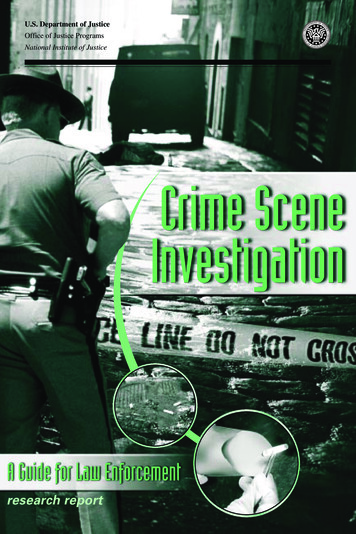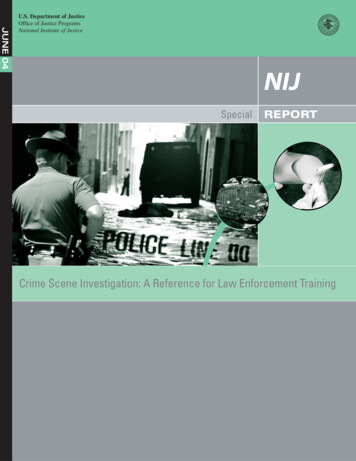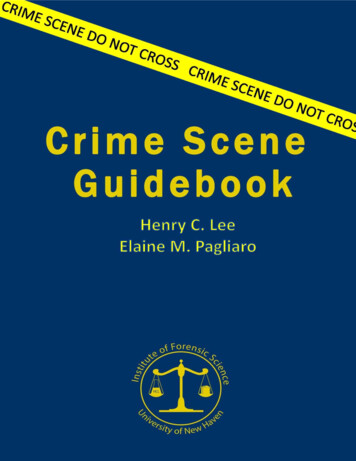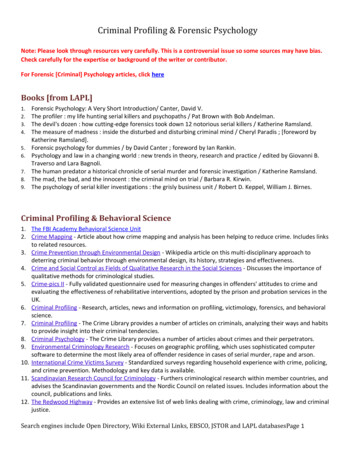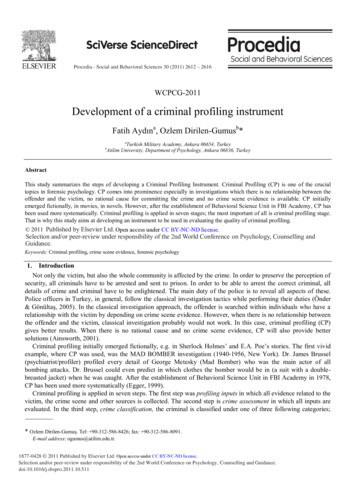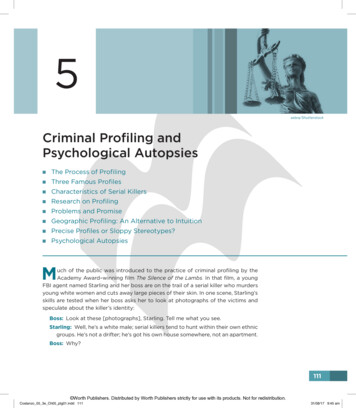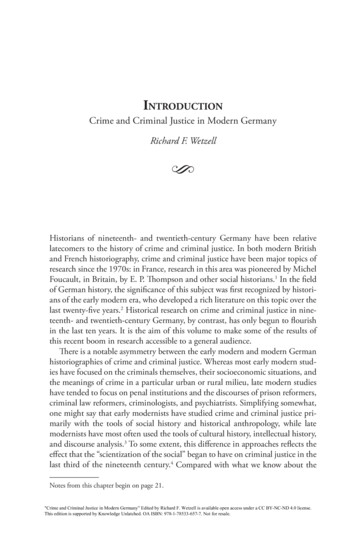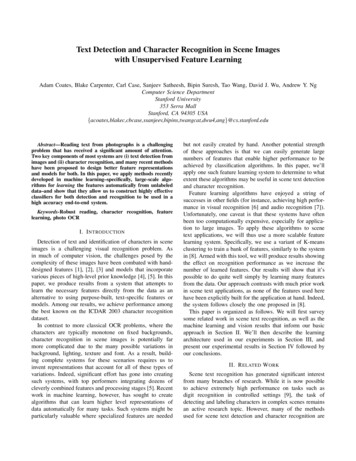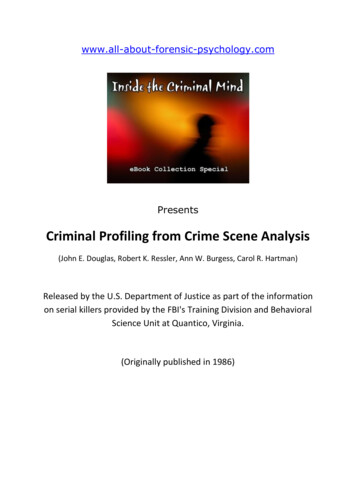
Transcription
nal Profiling from Crime Scene Analysis(John E. Douglas, Robert K. Ressler, Ann W. Burgess, Carol R. Hartman)Released by the U.S. Department of Justice as part of the informationon serial killers provided by the FBI's Training Division and BehavioralScience Unit at Quantico, Virginia.(Originally published in 1986)
Since the 1970s, investigative profilers at the FBI's Behavioral Science Unit (now part of the NationalCenter for the Analysis of Violent Crime) have been assisting local, state, and federal agencies innarrowing investigations by providing criminal personality profiles. An attempt is now being made todescribe this criminal-profile-generating process. A series of five overlapping stages lead to the sixthstage, or the goal of apprehension of the offender: (1) profiling inputs, (2) decision-process models,(3) crime assessment, (4) the criminal profile, (5) investigation, and (6) apprehension. Two keyfeedback filters in the process are: (a) achieving congruence with the evidence, with decisionmodels, and with investigation recommendations, and (6) the addition of new evidence."You wanted to mock yourself at me! . . . You did not know your Hercule Poirot." He thrust outhis chest and twirled his moustache.I looked at him and grinned . . . "All right then," I said. "Give us the answer to the problems - ifyou know it.""But of course I know it."Hardcastle stared at him incredulously "Excuse me. Monsieur Poirot, you claim that you knowwho killed three people. And why?.All you mean is that you have a hunch"I will not quarrel with you over a word Come now. Inspector. I know – really know I perceiveyou are still sceptic. But first let me say this. To be sure means that when the right solution isreached, everything falls into place. You perceive that in no other way could things havehappened. "(Christie 1963. pp. 227-228).The ability of Hercule Poirot to solve a crime by describing the perpetrator is a skill shared by theexpert investigative profiler. Evidence speaks its own language of patterns and sequences that canreveal the offender's behavioral characteristics. Like Poirot, the profiler can say . "I know who hemust be."This article focuses on the developing technique of criminal profiling. Special agents at the FBIAcademy have demonstrated expertise in crime scene analysis of various violent crimes, particularlythose involving sexual homicide. This article discusses the history of profiling and the criminalprofile-generating process and provides a case example to illustrate the technique.INTRODUCTION: HISTORY OF CRIMINAL PROFILINGCriminal profiling has been used successfully by law enforcement in several areas and is a valuedmeans by which to narrow the field of investigation. Profiling does not provide the specific identityof the offender. Rather, it indicates the kind of person most likely to have committed a crime byfocusing on certain behavioral and personality characteristics.Profiling techniques have been used in various settings such as hostage taking (Reiser. 1982). Lawenforcement officers need to learn as much as possible about the hostage taker in order to protectthe lives of the hostages. In such cases, police are aided by verbal contact (although often limited)with the offender and possibly by access to his family and friends. They must be able to assess thesubject in terms of what course of action he is likely to take and what his reactions to various stimulimight be.1
Profiling has been used also in identifying anonymous letter writers (Casey-Owens 1983) andpersons who make written or spoken threats of violence (Miron & Douglas 1979). In cases of thelatter psycholinguistic techniques have been used to compose a "threat dictionary." whereby everyword in a message is assigned by computer, to a specific category. Words as they are used in thethreat message are then compared with those words as they are used in ordinary speech or writings.The vocabulary usage in the message may yield "signature" words unique to the offender. In thisway, police may not only be able to determine that several letters were written by the sameindividual, but also to learn about the background and psychology of the offender.Rapists and arsonists also lend themselves to profiling techniques. Through careful interview of therape victim about the rapist's behaviour law enforcement personnel begin to build a profile of theoffender (Hazelwood. 1983). The rationale behind this approach is that behavior reflects personality,and by examining behavior the investigator may be able to determine what type of person isresponsible for the offense. For example, common characteristics of arsonists have been derivedfrom an analysis of the data from the FBI's Crime in the United States (Rider. 1980). Knowledge ofthese characteristics can aid the investigator in identifying possible suspects and in developingtechniques and strategies for interviewing them. However, studies in this area have focused onspecific categories of offenders and are not yet generalizable to all offenders.Criminal profiling has been found to be of particular usefulness in crimes such as serial sexualhomicides. These crimes create a great deal of fear because of their apparently random andmotiveless nature, and they are also given high publicity. Consequently law enforcement personnelare under great public pressure to apprehend the perpetrator as quickly as possible. At the sametime, these crimes may be the most difficult to solve, precisely because of their apparentrandomness.While it is not completely accurate to say that these crimes are motiveless, the motive may all toooften be one understood only by the perpetrator. Lunde (1976) demonstrates this issue in terms ofthe victims chosen by a particular offender. As Lunde points out, although the serial murderer maynot know his victims their selection is not random. Rather, it is based on the murderer's perceptionof certain characteristics of his victims that are of symbolic significance to him. An analysis of thesimilarities and differences among victims of a particular serial murderer provides importantinformation concerning the "motive" in an apparently motiveless crime. This in turn, may yieldinformation about the perpetrator himself. For example the murder may be the result of a sadisticfantasy in the mind of the murderer and a particular victim may be targeted because of a symbolicaspect of the fantasy (Ressler et al, 1985).In such cases, the investigating officer faces a completely different situation from the one in which amurder occurs as the result of jealousy or a family quarrel, or during the commission of anotherfelony. In those cases, a readily identifiable motive may provide vital clues about the identity of theperpetrator. In the case of the apparently motiveless crime, law enforcement may need to look toother methods in addition to conventional investigative techniques, in its efforts to identify theperpetrator. In this context, criminal profiling has been productive, particularly in those crimeswhere the offender has demonstrated repeated patterns at the crime scene.2
THE PROFILING OF MURDERERSTraditionally two very different disciplines have used the technique of profiling murderers: mentalhealth clinicians who seek to explain the personality and actions of a criminal through psychiatricconcepts, and law enforcement agents whose task is to determine the behavioral patterns' of asuspect through investigative concepts.Psychological ProfilingIn 1957, the identification of George Metesky the arsonist in New York City's Mad Bomber case(which spanned 16 years) was aided by psychiatrist-criminologist James A. Brussel's staccato-styleprofile:"Look for a heavy man. Middle-aged Foreign born. Roman Catholic. Single. Lives with a brotheror sister. When you find him chances are he'll be wearing a double-breasted suit. Buttoned."Indeed the portrait was extraordinary in that the only variation was that Metesky lived with twosingle sisters. Brussel in a discussion about the psychiatrist acting as Sherlock Holmes explains that apsychiatrist usually studies a person and makes some reasonable predictions about how that personmay react to a specific situation and about what he or she may do in the future. What is done inprofiling according to Brussel is to reverse this process. Instead, by studying an individual's deedsone deduces what kind of a person the individual might be (Brussel. 1968).The idea of constructing a verbal picture of a murderer using psychological terms is not new. In 1960Palmer published results of a three-year study of 51 murderers who were serving sentences in NewEngland. Palmer's "typical murderer" was 33 years old when he committed murder. Using a gun, thistypical killer murdered a male stranger during an argument. He came from a low social class andachieved little in terms of education or occupation. He had a well meaning but maladjusted motherand he experienced physical abuse and psychological frustrations during his childhood.Similarly, Rizzo (1982) studied 31 accused murderers during the course of routine referrals forpsychiatric examination at a court clinic. His profile of the average murderer listed the offender as a26-year-old male who most likely knew his victim with monetary gain the most probable motivationfor the crime.Criminal ProfilingThrough the techniques used today law enforcement seeks to do more than describe the typicalmurderer, if in fact there ever was such a person. Investigative profilers analyze informationgathered from the crime scene for what it may reveal about the type of person who committed thecrime.Law enforcement has had some outstanding investigators; however, their skills, knowledge andthought processes have rarely been captured in the professional literature. These people were trulythe experts of the law enforcement field, and their skills have been so admired that many fictionalcharacters (Sergeant Cuff, Sherlock Holmes, Hercule Poirot, Mike Hammer, and Charlie Chan) havebeen modeled on them. Although Lunde (1976) has stated that the murders of fiction bear noresemblance to the murders of reality, a connection between fictional detective techniques andmodem criminal profiling methods may indeed exist. For example, it is attention to detail that is the3
hallmark of famous fictional detectives; the smallest item at a crime scene does not escape theirattention. As stated by Sergeant Cuff in Wilkie Collins' The Moonstone, widely acknowledged as thefirst full-length detective study:At one end of the inquiry there was a murder, and at the other end there was a spot of ink on atablecloth that nobody could account for. In all my experience . . . I have never met with such athing as a trifle yet.However, unlike detective fiction, real cases are not solved by one tiny clue but the analysis of allclues and crime patterns.Criminal profiling has been described as a collection of leads (Rossi, 1982), as an educated attemptto provide specific information about a certain type of suspect (Geberth, 1981), and as a biographicalsketch of behavioral patterns, trends, and tendencies (Vorpagel, 1982). Geberth (1981) has alsodescribed the profiling process as particularly useful when the criminal has demonstrated some formof psychopathology. As used by the FBI profilers, the criminal-profile generating process is defined asa technique for identifying the major personality and behavioral characteristics of an individualbased upon an analysis of the crimes he or she has committed. The profiler's skill is in recognizingthe crime scene dynamics that link various criminal personality types who commit similar crimes.The process used by an investigative profiler in developing a criminal profile is quite similar to thatused by clinicians to make a diagnosis and treatment plan: data are collected and assessed, thesituation reconstructed, hypotheses formulated, a profile developed and tested, and the resultsreported back. Investigators traditionally have learned profiling through brainstorming, intuition,and educated guesswork. Their expertise is the result of years of accumulated wisdom, extensiveexperience in the field, and familiarity with a large number of cases.A profiler brings to the investigation the ability to make hypothetical formulations based on his orher previous experience. A formulation is defined here as a concept, that organizes, explains, ormakes investigative sense out of information, and that influences the profile hypotheses. Theseformulations are based on clusters of information emerging from the crime scene data and from theinvestigator's experience in understanding criminal actions.A basic premise of criminal profiling is that the way a person thinks (i.e., his or her patterns ofthinking) directs the person's behavior. Thus, when the investigative profiler analyzes a crime sceneand notes certain critical factors, he or she may be able to determine the motive and type of personwho committed the crime.THE CRIMINAL-PROFILE-GENERATING PROCESSInvestigative profilers at the FBI's Behavioral Science Unit (now part of the National Center for theAnalysis of Violent Crime [NCAVC]) have been analyzing crime scenes and generating criminalprofiles since the 1970s. Our description of the construction of profiles represents the off-siteprocedure as it is conducted at the NCAVC, as contrasted with an on-site procedure (Ressler et al.1985). The criminal-profile-generating process is described as having five main stages with a sixthstage or goal being the apprehension of a suspect (see Fig. 1).4
Figure 1: Criminal Profile Generating Process1. Profiling Inputs StageThe profiling inputs stage begins the criminal-profile-generating process. Comprehensive casematerials are essential for accurate profiling. In homicide cases, the required information includes acomplete synopsis of the crime and a description of the crime scene, encomp
www.all-about-forensic-psychology.com Presents Criminal Profiling from Crime Scene Analysis (John E. Douglas, Robert K. Ressler, Ann W. Burgess, Carol R. Hartman) Released by the U.S. Department of Justice as part of the information on serial killers provided by the FBI's Training Division and Behavioral Science Unit at Quantico, Virginia.
